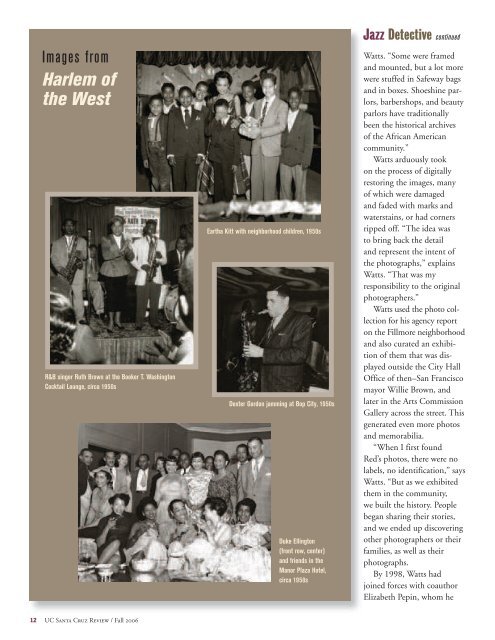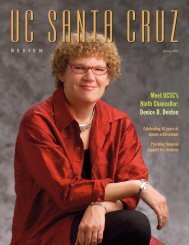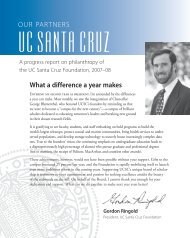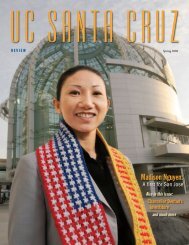when Nanomeets Bio - Review Magazine - University of California ...
when Nanomeets Bio - Review Magazine - University of California ...
when Nanomeets Bio - Review Magazine - University of California ...
Create successful ePaper yourself
Turn your PDF publications into a flip-book with our unique Google optimized e-Paper software.
Images from<br />
Harlem <strong>of</strong><br />
the West<br />
R&B singer Ruth Brown at the Booker T. Washington<br />
Cocktail Lounge, circa 1950s<br />
12 UC Santa Cruz <strong>Review</strong> / Fall 2006<br />
Eartha Kitt with neighborhood children, 1950s<br />
Dexter Gordon jamming at Bop City, 1950s<br />
Duke Ellington<br />
(front row, center)<br />
and friends in the<br />
Manor Plaza Hotel,<br />
circa 1950s<br />
Jazz Detective continued<br />
Watts. “Some were framed<br />
and mounted, but a lot more<br />
were stuffed in Safeway bags<br />
and in boxes. Shoeshine parlors,<br />
barbershops, and beauty<br />
parlors have traditionally<br />
been the historical archives<br />
<strong>of</strong> the African American<br />
community.”<br />
Watts arduously took<br />
on the process <strong>of</strong> digitally<br />
restoring the images, many<br />
<strong>of</strong> which were damaged<br />
and faded with marks and<br />
waterstains, or had corners<br />
ripped <strong>of</strong>f. “The idea was<br />
to bring back the detail<br />
and represent the intent <strong>of</strong><br />
the photographs,” explains<br />
Watts. “That was my<br />
responsibility to the original<br />
photographers.”<br />
Watts used the photo collection<br />
for his agency report<br />
on the Fillmore neighborhood<br />
and also curated an exhibition<br />
<strong>of</strong> them that was displayed<br />
outside the City Hall<br />
Office <strong>of</strong> then–San Francisco<br />
mayor Willie Brown, and<br />
later in the Arts Commission<br />
Gallery across the street. This<br />
generated even more photos<br />
and memorabilia.<br />
“When I first found<br />
Red’s photos, there were no<br />
labels, no identification,” says<br />
Watts. “But as we exhibited<br />
them in the community,<br />
we built the history. People<br />
began sharing their stories,<br />
and we ended up discovering<br />
other photographers or their<br />
families, as well as their<br />
photographs.<br />
By 1998, Watts had<br />
joined forces with coauthor<br />
Elizabeth Pepin, whom he<br />
met <strong>when</strong> she was conducting<br />
research for a PBS documentary<br />
on the history <strong>of</strong><br />
the Fillmore District. Pepin<br />
had been employed by Bill<br />
Graham Presents as manager<br />
and historian <strong>of</strong> the<br />
Fillmore Auditorium in the<br />
mid-1980s. Since both Watts<br />
and Pepin were making plans<br />
to create a book about the<br />
Fillmore community, they<br />
decided to collaborate on<br />
Harlem <strong>of</strong> the West.<br />
“Elizabeth primarily handled<br />
interviews and text, and<br />
I handled obtaining, restoring,<br />
and curating the photos,”<br />
says Watts, who joined<br />
the UC Santa Cruz faculty<br />
in 2001, halfway through the<br />
10-year project.<br />
The book was published<br />
in January by Chronicle<br />
Books and celebrated with<br />
an exhibition, reception, and<br />
concert in February at the<br />
San Francisco Performing<br />
Arts Library & Museum.<br />
Performing at the event was<br />
the Fillmore Jazz Preservation<br />
Big Band, a 20-piece orchestra<br />
featuring many top Bay<br />
Area jazz musicians under<br />
the direction <strong>of</strong> UC Santa<br />
Cruz director <strong>of</strong> jazz studies<br />
Karlton Hester.<br />
Harlem <strong>of</strong> the West captures<br />
a joyful and momentous<br />
era in the country’s African<br />
American musical history.<br />
It serves as a reflection <strong>of</strong> a<br />
magical place at a remarkable<br />
time. And, as Watts optimistically<br />
notes: “Knowledge <strong>of</strong><br />
the past can hopefully lead to<br />
a renaissance in the future.”<br />
Harlem <strong>of</strong> the West is available from<br />
Bay Tree Bookstore; see page 29.<br />
Advertisement for<br />
Louis Armstrong at<br />
the New Orleans<br />
Swing Club, 1950s<br />
Billie Holiday, her beloved Chihuahua, and<br />
Wesley Johnson Sr. at the Club Flamingo,<br />
in the early 1950s<br />
Charles Sullivan (left), one <strong>of</strong> the most active promoters <strong>of</strong> African<br />
American music west <strong>of</strong> the Mississippi. In the middle is Lionel<br />
Hampton wearing Wesley Johnson Sr.’s cowboy hat.<br />
Patrons <strong>of</strong> the Texas Playhouse, early 1950s<br />
John Handy, Pony Poindexter, John Coltrane, and Frank Fisher at Jimbo’s Bop City, 1950s<br />
UC Santa Cruz <strong>Review</strong> / Fall 2006 13





